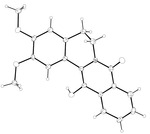
This is a textbook and accompanying solutions manual for an introductory organic chemistry course.

This is a textbook and accompanying solutions manual for an introductory organic chemistry course.
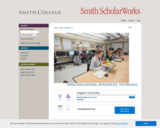
Chapter 1: Pericyclic Reactions
Chapter 2: Transition Metal Catalyzed Carbon-Carbon Bond Forming Reactions
Chapter 3: Neighboring Group Participation, Rearrangements, and Fragmentations
Chapter 4: Radical Reactions
Chapter 5: Carbene Reactions
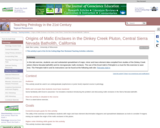
In this lab exercise, students use and substantial spreadsheet of major, minor and trace element data compiled from studies of the Dinkey Creek pluton (Sierra Nevada batholith) and its microgranular mafic enclaves. The use of the Excel Add-in Petroplot is a must for this exercise to save time. The Petroplot Add-in and its instructions can be found at the following web site: Petroplot Add-in
Some familiarity with Excel is assumed. I've included a handout introducing the problem and discussing mafic enclaves in the Sierra Nevada batholith. Pictures of typical enclaves are provided and can be dumped into Powerpoint for lecture purposes. Several questions [and answers] about to the student-produced graphs are included, but certainly are not exhaustive. The utility of the exercise is to familiarize students with major and trace element discrimination diagrams and spreadsheet databases as tools to consider if magma mixing can explain the origin of the mafic enclaves in this pluton.
(Note: this resource was added to OER Commons as part of a batch upload of over 2,200 records. If you notice an issue with the quality of the metadata, please let us know by using the 'report' button and we will flag it for consideration.)

Short Description:
This book is an educational, entertaining, and highly personal memoir written during a global pandemic. It provides an insightful snapshot of the occasionally bumpy yet spiritually transformative cancer journey of a middle-aged, immigrant, and non-partnered academic living in a sunny Canadian prairie province.
Long Description:
This book is an educational, entertaining, and highly personal memoir written during a global pandemic. It provides an insightful snapshot of the occasionally bumpy yet spiritually transformative cancer journey of a middle-aged, immigrant, and non-partnered academic living in a sunny Canadian prairie province.
It will be of interest to anyone who: 1) is or has been on the cancer continuum as a patient, caregiver, family member, or friend; 2) is or strives to be a health professional (oncologist, GP, nurse, social worker, pharmacist, physio- or exercise therapist, etc.); 3) is an administrator, instructor, teaching assistant, or student at a post-secondary institution interested in health sciences, English literature (memoir writing, creative non-fiction, and narratives of illness), Women’s and Gender Studies, Spirituality Studies, Religious Studies, and the Fine Arts; 4) fellow authors and/or readers who like to give writers from the Canadian prairies a chance.
The Appendix includes “Leading Reading Questions” meant to increase everyone’s reading experience and lighten the load of fellow university professors who wish to adopt this book, or part of this book, for a class.
Word Count: 53928
ISBN: 978-0-7731-0764-9
(Note: This resource's metadata has been created automatically by reformatting and/or combining the information that the author initially provided as part of a bulk import process.)
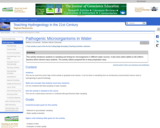
Pathogenic Microorganisms in Water: Traditionally, groundwater has been used without treatment because the soil acts as a filter, removing pathogenic microorganisms. Some potential sources of pathogens (or disease causing organisms) in groundwater include septic tanks, leaking sewer lines, sewage sludge, intentional groundwater recharge with sewage, irrigation with sewage, direct injection of sewage, domestic solid waste disposal (landfills) and sewage oxidation ponds. The objective of the session is to introduce hydrogeologist to the types of microorganisms, sources of pathogens, and a simple exercise that can be incorporated into a hydrogeology class.
(Note: this resource was added to OER Commons as part of a batch upload of over 2,200 records. If you notice an issue with the quality of the metadata, please let us know by using the 'report' button and we will flag it for consideration.)
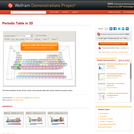
This Demonstration shows 3D bar charts of the periodic table with various element property values.
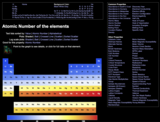
This chemistry activity was created to enhance student learning about periodic trends. The activity utilizes a dynamic visualization tool for the periodic table and elements enabling exploration of trends based on atomic size, ionization energy, covalent radius, and many more.
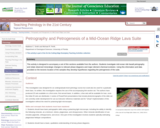
This is a laboratory-style investigation wherein students examine the petrography and major-element geochemistry of 6 samples of mid-ocean ridge basalt and related differentiated lavas recovered from the Cleft segment of southern Juan de Fuca Ridge, a medium spreading-rate MOR in the northeast Pacific Ocean. Lava types range from basalt to dacite.
After some initial background information on basalts, the MOR environment, and the study area students investigate four thin sections, beginning with typical basalts and ending with a dacite. They are led through a series of directed questions that help them gain familiarity with commonly occurring minerals and textures in mid-ocean ridge lavas. Questions direct students toward the interpretation of quench-related textural features and crystallization sequence, as well as a few other textural observations and petrographic techniques. After proceeding through the initial four thin sections and associated questions student are then asked to undertake "full thin-section descriptions" of the remaining two samples.Â
After investigating the thin-sections and determining a possible crystallization sequence from the petrographic data gathered (plagioclase followed by olivine followed by augitic clinopyroxene followed by pigeonite), students examine a P-T phase diagram to constrain possible pressures of formation. Discovering that crystallization pressures were low (less than ~ 0.75 GPa) students then examine a phase diagram of the olivine-plagioclase-augite-quartz system (olivine-quartz-augite ternary, projected from the plane of plagioclase saturation) [Walker, 1979]. Students draw 2 possible liquid lines of descent (LLD) onto the diagram, and then use their petrographic observations to qualitatively plot the samples along that LLD, determining a relative sequence of chemical evolution for the suite of samples. Lastly, given those determinations, student graph the major element data for the lava suite to infer paths of chemical evolution and the effects of fractional crystallization (possibly coupled with magma mixing).
(Note: this resource was added to OER Commons as part of a batch upload of over 2,200 records. If you notice an issue with the quality of the metadata, please let us know by using the 'report' button and we will flag it for consideration.)

Pre-lab material provides background on the Hawaiian hotspot and the current eruption utilizing maps, diagrams, information, photographs, and video footage of the Pu'u 'Ō'ō eruption with written questions that test understanding of this material.
Examination of hand samples (available on request) and photomicrographs of lavas from a distinct interval of the Pu'u 'Ō'ō eruption with group partners in lab.
Working within groups assigned to particular intervals of the eruption to make time-series analyses of lava geochemistry from the Pu'u 'Ō'ō eruption to evaluate crustal processes of magmatic evolution.
Interpretation and synthesis of background information, petrography, and geochemistry, and presentation of results and interpretation with group partners at the beginning of the next lab period.
(Note: this resource was added to OER Commons as part of a batch upload of over 2,200 records. If you notice an issue with the quality of the metadata, please let us know by using the 'report' button and we will flag it for consideration.)
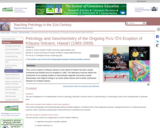
Pre-lab material provides background on the Hawaiian hotspot and the current eruption utilizing maps, diagrams, information, photographs, and video footage of the Pu'u 'Ō'ō-Kupaianaha eruption with written questions that test understanding of this material.
Examination of hand samples and thin-sections of lavas from a distinct interval of the Pu'u 'Ō'ō-Kupaianaha eruption with group partners in lab.
Working within groups assigned to particular intervals of the eruption to make time-series analyses of whole-rock geochemistry from the Pu'u 'Ō'ō-Kupaianaha eruption to evaluate crustal processes of magmatic evolution.
Interpretation and synthesis of background information, petrography, and geochemistry, and presentation of results and interpretation with group partners at the beginning of the next lab period.
(Note: this resource was added to OER Commons as part of a batch upload of over 2,200 records. If you notice an issue with the quality of the metadata, please let us know by using the 'report' button and we will flag it for consideration.)
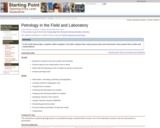
In this multi-week project, students collect samples in the field, analyze them using various tools and instruments, then present their results and interpretations.
(Note: this resource was added to OER Commons as part of a batch upload of over 2,200 records. If you notice an issue with the quality of the metadata, please let us know by using the 'report' button and we will flag it for consideration.)

Teachers have access to simulation-specific tips and video primers, resources for teaching with simulations, and activities shared by our teacher community.
Simulations:
• Density
• Build a Molecule
• Diffusion
• Gases Intro
• Gas Properties
• Energy Forms and Changes
• Coulomb’s Law
• Molecule Polarity
• States of Matter: Basics
• States of Matter
• Atomic Interactions
• Rutherford Scattering
• Isotopes and Atomic Mass
• Molecules and Light
• Molecule Shape
• Molecule Shapes: Basics
• Reactants, Products and Leftovers
• pH Scale: Basics
• pH Scale
• Wave on a String
• Balancing Chemical Equations
• Acid-Base Solutions
• Concentrations
• Balloons and Static Electricity
• Beer’s Law Lab
• Molarity
• Build an Atom

Students will use X-ray diffraction to determine the composition of an "unknown" feldspar and then perform experiments to change the phase and composition of the feldspar.
(Note: this resource was added to OER Commons as part of a batch upload of over 2,200 records. If you notice an issue with the quality of the metadata, please let us know by using the 'report' button and we will flag it for consideration.)
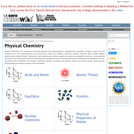
Physical Chemistry is the application of physical principles and measurements to understand the properties of matter, as well as for the development of new technologies for the environment, energy and medicine. Advanced Physical Chemistry topics include different spectroscopic methods (Raman, ultrafast and mass spectroscopy, nuclear magnetic and electron paramagnetic resonance, x-ray absorption and atomic force microscopy) as well as theoretical and computational tools to provide atomic-level understanding for applications such as: nanodevices for bio-detection and receptors, interfacial chemistry of catalysis and implants, electron and proton transfer, protein function, photosynthesis and airborne particles in the atmosphere.

The Central American volcanic arc displays large arc-parallel variations in chemical composition that yield important clues concerning the complex origin of magmas in subduction zones. In this exercise, students use data compiled for the NSF MARGINS program to compare heights, volumes, and whole-rock compositions of 39 Quaternary volcanic centers along the Central American arc, together with crustal thicknesses, to assess the possible sources of the magmas and the petrologic processes that have modified them prior to eruption.
(Note: this resource was added to OER Commons as part of a batch upload of over 2,200 records. If you notice an issue with the quality of the metadata, please let us know by using the 'report' button and we will flag it for consideration.)

Short Description:
A second semester introductory physics course for life sciences students that looks to deepen students' understanding of biology and chemistry through physics all through the lens of understanding two of the most fundamental particles in the Universe: electrons and photons. The book begins with exploring the quantum mechanical nature of these objects to expand on what students have learned in chemistry and then proceeds to geometric optics (using the human eye as a theme), electrostatics (using membrane potentials), circuits (using the neuron), and finally synthesizing everything in a unit exploring the meaning of "light is an electromagnetic wave."
Long Description:
A second semester introductory physics course for life sciences students that looks to deepen students’ understanding of biology and chemistry through physics all through the lens of understanding two of the most fundamental particles in the Universe: electrons and photons. The book begins with exploring the quantum mechanical nature of these objects to expand on what students have learned in chemistry and then proceeds to geometric optics (using the human eye as a theme), electrostatics (using membrane potentials), circuits (using the neuron), and finally synthesizing everything in a unit exploring the meaning of “light is an electromagnetic wave.”
Word Count: 97595
ISBN: 978-1-945764-07-3
(Note: This resource's metadata has been created automatically by reformatting and/or combining the information that the author initially provided as part of a bulk import process.)
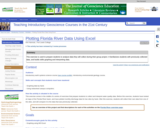
Students graph existing water quality data using MS Excel, and use the graphs to discuss the changes in discharge, sediment load, and dissolved load along the length of the river and over time. This exercise prepares students to analyze and discuss their own data later in the semester.
(Note: this resource was added to OER Commons as part of a batch upload of over 2,200 records. If you notice an issue with the quality of the metadata, please let us know by using the 'report' button and we will flag it for consideration.)
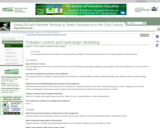
This assignment will introduce students to surface hydrologic modeling in GIS and derived products such as stream power and wetness indices.
(Note: this resource was added to OER Commons as part of a batch upload of over 2,200 records. If you notice an issue with the quality of the metadata, please let us know by using the 'report' button and we will flag it for consideration.)
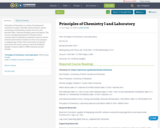
Principles of Chemistry is a study of fundamental chemical concepts: scientific measurements, matter and energy, stoichiometry, atomic structure, the periodic table, chemical bonding, gases and liquids. The course is designed primarily for students with a concentration in biological or physical sciences and for students interested in transfer to a four-year program in engineering. A three-hour lab session is required each week. All course content created by Kimberly Stieglitz. Content added to OER Commons by Julia Greider.
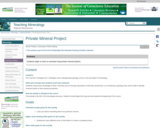
In this semester-long private mineral project, students become experts on one mineral. They write a paper about their mineral and use key information about it to publish a web page. Information should include provenance, physical properties, composition, recent related literature, photos of samples, optical properties, x-ray pattern, crystallography, economic value, atomic structure, other closely related minerals, associated myths, and a complete list of references based on GSA format.
(Note: this resource was added to OER Commons as part of a batch upload of over 2,200 records. If you notice an issue with the quality of the metadata, please let us know by using the 'report' button and we will flag it for consideration.)